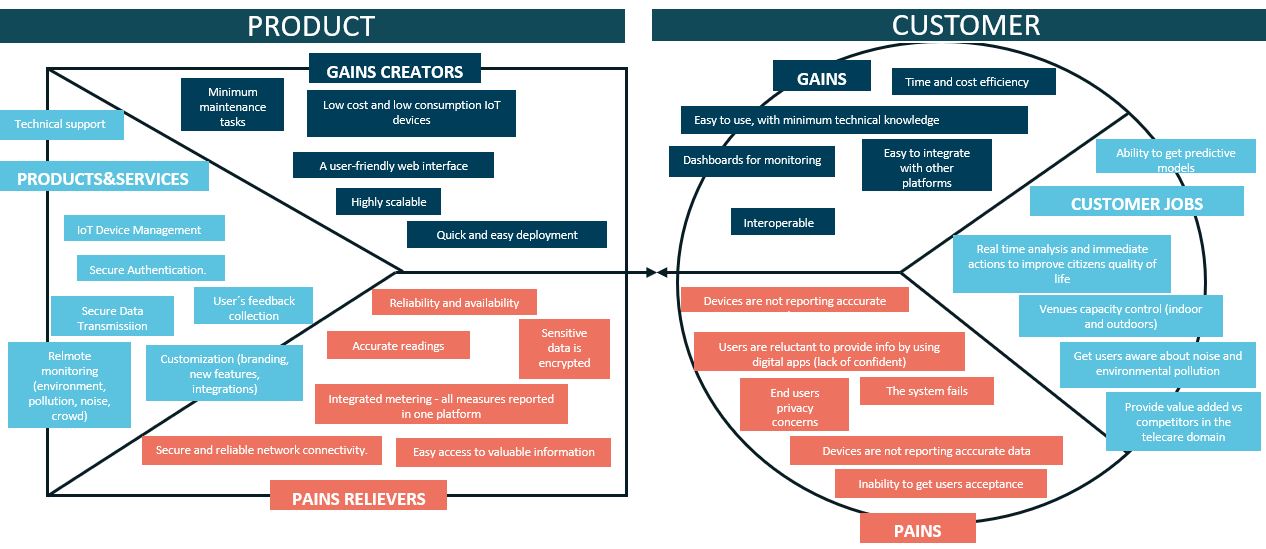Use Case 1 · Secured IoT devices to enrich strolls across smart city parks (Santander, Spain)
Overall description
This pilot focuses on deploying IoT devices offering environmental information such as temperature, humidity, CO2 and Volatile Organic Compounds, as well as an estimated measurement of the number of visitors in the Las Llamas park (Santander, north of Spain). This kind of information is significant to the well-being of the city’s inhabitants.
Challenges it addresses
The information provided by M-Sec will complement and enrich the one currently existing in the smart city and will help the Municipality to extract valuable conclusions through the observation of diverse areas in the Las Llamas park, one of the city lungs. Besides, the pilot aims to progress on security measures through both HW and SW approaches, so that privacy of citizens is preserved, and measurements are protected from malicious attacks.
(left click the picture for a better view)
The M-Sec approach
Under the M-Sec framework the data collected by the IoT devices are sent to different components:
- The Eclipse sensiNact Platform receives the data through an MQTT connection. There, sensiNact users can visualize the devices and the data and establish their very own analysis.
- The Crypto Companion Database (CCDB) encrypts the data with an asymmetric public/private key pair. Data can only be accessed by the owner who has to be authenticated, and the authorised operators allowed by that owner. At the same time, a hash is generated from all the encrypted data and stored in the Quorum blockchain for data tamper proof.
- The marketplace makes all the data available for the public because it doesn’t contain any personal data related to the end user. In the marketplace stakeholders who may be interested on getting this kind of environmental and number of visitors data can buy it using the so-called M-Sec Tokens, which is a cryptocurrency in the form of a smart contract running on blockchain.
Pilot implementation
The system relies into two different IoT devices developed within the project. One of them is a so-called people counter device, and it is capable of detecting Wi-Fi and BT MAC addresses and offering a figure which is an estimation of the number of people in the surroundings of that specific spot at that moment in time. This device is installed in one of the hot spots of the Las Llamas Park, just in the level below its restaurant.
The other devices are in charge of performing environmental monitoring by measuring temperature, humidity, CO2, VOC and noise. The five locations considered for the five sensors that are deployed imply covering on the one hand the child’s playground area and on the other hand a complete longitudinal section of the park, going from one side, closer to the University of Cantabria, to the other, just next to a residential area, covering the city motorway which separates this housing zone and the park itself as well.
In the search to complement the service offer, the system offers extended information about 9 specific points of the park where visitors receive specific data about what they can find there. To enable M-Sec pilot users to access this data, 9 QR codes have been distributed throughout the park. Reading these codes allows access to the web application that presents this information together with the data collected by the IoT devices, properly decrypted in the server. In the web app, which is ingrained in the M-Sec application layer, people can join the pilot through a simple registration process and thus have access to all the data offered.
Once registered, users may visit the specific sections allocated to those 9 places to visit or to the IoT devices scattered though the park, where they will be able to check the information and measurements registered and even deposit their satisfaction degree through a simple 5-star rating method that will help M-Sec partners in charge of Use Case 1 get to know how useful the service is according to its participants.
(left click the picture for a better view)
Main results and next steps
Sensors deployed at Las Llamas park are currently generating data that is being made publicly available through the marketplace allowing interested stakeholders to buy the data generated in the pilot.
Besides, taking advantage of the scalability achieved with the M-Sec framework new deployments in other relevant areas, not only of the city of Santander, but also in villages in the region and in relevant mid-size cities nearby (e.g., Gijón, León) will be possible.
Lessons Learnt
The main lesson learnt has to do with the reliability/accuracy of the measurements provided by the low-cost sensors integrated within the prototype. In this regard, there was a concern about the accuracy of the provided measurements since low-cost sensors are less reliable compared to the high-end sensors used by meteorological services commonly used by citizens. For this reason, a further effort should be made to ensure the validity of the measured data through their calibration and the implementation of error compensation mechanisms.
In conclusion, the sustainability of the pilot will require the industrialization of the developed prototypes to ensure the reliability of the data provided. From the end-users’ point of view, they liked the experience of walking around the park reading the QR codes, especially those who went with children.
How can I join?
Contact Alberto Puras: apuras@tst-sistemas.es




